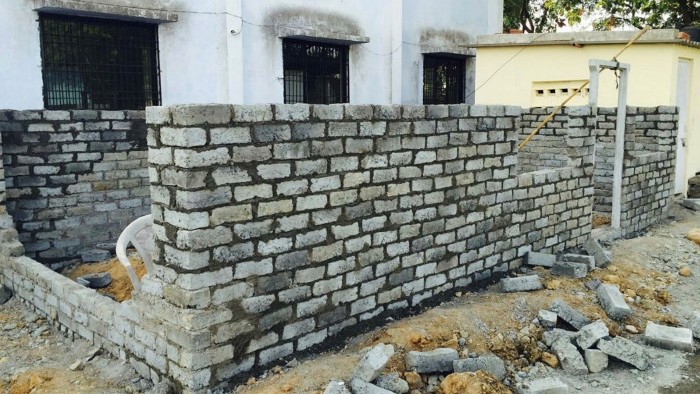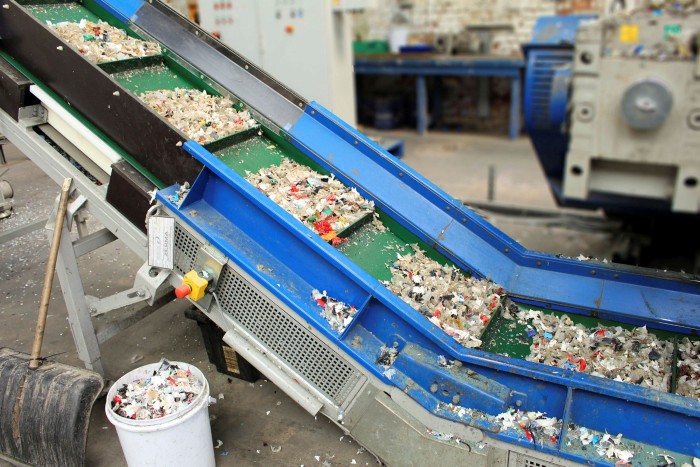Recyclers tackle pandemic face masks and wrappings

Roula Khalaf, Editor of the FT, selects her favourite stories in this weekly newsletter.
At the start of the coronavirus pandemic, as factory production fell and most people stayed at home, there was one potential silver lining: that nature would benefit. But Binish Desai, head of a recycling business in Valsad, India, was struck by another pandemic effect — the increased use of plastic.
“I started noticing the utilisation of single-use face masks and PPE kits,” says Desai, 26-year-old founder of Eco Eclectic Technologies. “All this material was going to be produced once and be directly discarded, not recycled, because of its use in the pandemic.”
Desai saw a potential use for the plastic face masks he disposed of daily after personal use. He disinfected and shredded them, then mixed them with byproducts from chewing gum manufacturing and paper mill waste, which act as a binder and pulp.
The result was a brick for use in building construction that, he says, is three times stronger than conventional versions in India.
These bricks — which use about 150 to 200 masks per cubic foot and have been used to build houses, schools and toilets — are now a core part of Desai’s business, which produces 7,000 to 8,000 per day. Roughly 3,000 bricks will build a 200 sq ft room.

But innovations such as Desai’s are tiny compared with the number of single-use plastics made, used and immediately discarded, because of the pandemic. And this trend is counter to the aim of the circular economy to shift production and consumption away from linear take-make-dispose models.
In November, a study by researchers at Nanjing University and the University of California San Diego found that the pandemic had generated roughly 8.4mn tons of excess “mismanaged” — that is to say, not handled or recycled — plastic waste, from 193 countries. And, while 7.6 per cent is from individuals’ use, such as face masks, the vast majority — 87.4 per cent — comes from hospitals. Much of it is incinerated to eradicate infected materials.
However, some initiatives have shown that clinical waste can be both decontaminated and recycled. In the UK, Cardiff-based Thermal Compaction Group’s “SteriMelt” machine — now in several UK hospitals — sterilises and melts protective masks, wrappings and drapes into reusable plastic briquettes.
Another UK company, ReWorked, holds PPE in “quarantine” for 72 hours, before shredding and moulding the waste into plastic boards for use in construction, joinery and shopfitting.

In India, Desai’s company partners with a medical waste facility that sterilises syringes and face shields so they are safe for recycling. “Sustainability is not expensive, we need mass market solutions not just lab solutions,” Desai comments.
It is not just medical waste that will require a mass market solution, though. While single-use PPE caught the headlines, packaging material led to 4.7 per cent of the excess waste because of the pandemic’s boom in online shopping, according to the Nanjing University and University of California study.
“The thought was that people were going to stay at home and there’d be a downturn in economic activity, but instead people went home and shopped online,” says Jeremy Pafford, North America head at global commodity market analysts Independent Commodity Intelligence Services.
Pafford says consumer pressure has led to “growing demand” for such packaging to be recycled or recyclable, but progress is “slow”. It is also more expensive. In December 2021, the price of European recycled polyethylene terephthalate, suitable for food use — and one of the most expensive plastics resins — was $2,169.96 per tonne, while its “virgin” equivalent was $1,757.85.
“The recycling facilities still have high costs,” says Paula Leardini, a senior plastics recycling analyst at ICIS. “Supply is short, first because of the recyclability of materials — and we still have limitations on sorting and collection, with different countries and different cities’ public collections being efficient, or not. And collection rates are still very low.”
More stories from this report
Could a better answer lie elsewhere? “If you use a compostable-certified plastic [which decomposes in industrial facilities], you can’t collect it with plastics but you can collect it with your food waste,” says David Newman, founder of UK trade body, the Bio-based and Biodegradable Industries Association. “You can put that back to soil.”
But, he admits, “that’s the theory but of course it doesn’t work that well in practice.”
First, it would require global standards for food waste collections, which remains a remote ideal because of differing standards within countries, cities, and even local districts. The UK, for example, has only recently pledged to separate food waste collections by 2023. In the EU, it will be mandatory by 2024. And, Newman argues, certain packaging mandates would also be necessary for the move to be successful.
“You’ve got to be able to guarantee a clean waste stream,” he says. “You can’t say to a compost plant, ‘I’m going to give you 50 per cent plastic tea bags and 50 per cent compostable’, because they have to reject the whole lot.” In October 2021, UK campaigning organisation A Plastic Planet set out why it recommended compostable mandates for specific items, such as food bin liners, carrier bags, tea bags, coffee pods and fruit and vegetable stickers.
In Newman’s view, such mandates are a pill society must swallow. “It’s a bit like the deal we made with electric cars, where we say, ‘OK, by 2030 your car’s got to be electric, deal with it,’” he argues. To ensure a clean waste stream for packaging, “we have to mandate that it’s only plastic compostables,” he says.
Comments